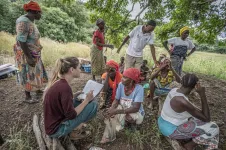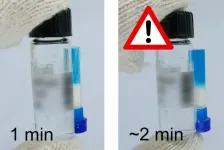Dermatologist perceptions of teledermatology implementation, future use after COVID-19
2021-03-31
(Press-News.org) What The Study Did: This study sought to assess dermatologists' perceptions of and experiences with teledermatology in the context of the COVID-19 pandemic and new regulatory changes including parity in reimbursements between video and in-person visits.
Authors: Jules B. Lipoff, M.D., of the Perelman School of Medicine at the University of Pennsylvania in Philadelphia, is the corresponding author.
To access the embargoed study: Visit our For The Media website at this link https://media.jamanetwork.com/
(doi:10.1001/jamadermatol.2020.0195)
Editor's Note: The article includes conflict of interest disclosures. Please see the article for additional information, including other authors, author contributions and affiliations, conflict of interest and financial disclosures, and funding and support.
INFORMATION:
Media advisory: The full study is linked to this news release.
Embed this link to provide your readers free access to the full-text article This link will be live at the embargo time https://jamanetwork.com/journals/jamadermatology/fullarticle/10.1001/jamadermatol.2021.0195?guestAccessKey=d92ee468-3dce-4e95-b610-99d3868f0524&utm_source=For_The_Media&utm_medium=referral&utm_campaign=ftm_links&utm_content=tfl&utm_term=033121
ELSE PRESS RELEASES FROM THIS DATE:
2021-03-31
What The Study Did: Researchers compared mortality and severe adverse events in this systematic review and meta-analysis of 52 studies that evaluated clinical outcomes among nearly 102,000 patients with COVID-19 who did and didn't receive angiotensin-converting enzyme inhibitors (ACEIs) or angiotensin receptor blockers (ARBs).
Authors: Vassilios S. Vassiliou, M.B.B.S., Ph.D., of the University of East Anglia in Norwich, United Kingdom is the corresponding author.
To access the embargoed study: Visit our For The Media website at this link https://media.jamanetwork.com/
(doi:10.1001/jamanetworkopen.2021.3694)
Editor's Note: The article includes conflict of interest disclosures. Please see the article for additional information, including other authors, ...
2021-03-31
What The Study Did: This study identified risk factors for SARS-CoV-2 incidence, hospitalization and death among nursing home residents in the United States.
Authors: James S. Goodwin, M.D., of the University of Texas Medical Branch in Galveston, is the corresponding author.
To access the embargoed study: Visit our For The Media website at this link https://media.jamanetwork.com/
(doi:10.1001/jamanetworkopen.2021.6315)
Editor's Note: The article includes funding/support disclosures. Please see the article for additional information, including other authors, author contributions and affiliations, conflict of interest and financial disclosures, and funding and support.
INFORMATION:
Media ...
2021-03-31
What The Study Did: This study documented how perception of risk of infection and severe complications from COVID-19 were associated with underlying reported health.
Authors: Robert F. Schoeni, Ph..D., of the University of Michigan in Ann Arbor, is the corresponding author.
To access the embargoed study: Visit our For The Media website at this link https://media.jamanetwork.com/
(doi:10.1001/jamanetworkopen.2021.3984)
Editor's Note: The article includes conflict of interest and funding/support disclosures. Please see the article for additional information, including other authors, author contributions and affiliations, conflict of interest ...
2021-03-31
What The Study Did: In this decision analytical modelling study, researchers investigated the association of school reopening or closure with new and cumulative COVID-19 case numbers compared with other community-based interventions.
Authors: David Naimark, M.D., M.Sc., of the Sunnybrook Health Sciences Centre in Toronto, Canada, is the corresponding author.
To access the embargoed study: Visit our For The Media website at this link https://media.jamanetwork.com/
(doi:10.1001/jamanetworkopen.2021.3793)
Editor's Note: The article includes conflict of interest and funding/support disclosures. Please see the article for additional information, including other authors, author contributions and affiliations, conflict ...
2021-03-31
CAMBRIDGE, MA -- Thousands of different bacterial species live within the human gut. Most are beneficial, while others can be harmful. A new study from an MIT-led team has revealed that these bacterial populations can remake themselves within the lifetime of their host, by passing genes back and forth.
The researchers also showed that this kind of gene transfer occurs more frequently in the microbiomes of people living in industrialized societies, possibly in response to their specific diets and lifestyles.
"One unexpected consequence of humans living ...
2021-03-31
For middle-aged women, exercise has many health benefits, but it may not help maintain cognitive function over the long term, according to a new UCLA Health study. The study observed a diverse group of roughly 1,700 women over a 21-year period starting when the women's average age was 45. In the study, women's cognitive ability was tested in three key areas: cognitive processing speed (how fast the mind works); verbal memory (the ability to recall a story that they heard); and working memory (the ability to manipulate information).
The study was published in JAMA Network Open, and is one of the first ...
2021-03-31
LA JOLLA, CA--What's the difference between a giggle and a belly laugh? Or a yelp and an all-out scream? In many species, including humans, the volume and duration of a verbal sound conveys as much information as the noise itself.
A group of scientists, led by Scripps Research, has discovered a node in the brains of male mice that modulates the sounds they make in social situations. This discovery, published in Nature, could help identify similar locations in the human brain, and potentially lead to a better understanding of social disorders such as autism or depression.
"Identifying this node gives us signatures of what to look for when human behavior goes awry," says Lisa Stowers, PhD, a neuroscientist and professor at Scripps Research who led the study. ...
2021-03-31
Harvard University researchers have identified the biological mechanism of how chronic stress impairs hair follicle stem cells, confirming long-standing observations that stress might lead to hair loss.
In a mouse study published in the journal Nature, the researchers found that a major stress hormone causes hair follicle stem cells to stay in an extended resting phase, without regenerating the hair follicle and hair. The researchers identified the specific cell type and molecule responsible for relaying the stress signal to the stem cells, and showed that this pathway can be potentially targeted to restore hair growth.
"My lab is interested in understanding how stress affects ...
2021-03-31
Swansea University physicists, as leading members of the ALPHA collaboration at CERN, have demonstrated laser cooling of antihydrogen atoms for the first time. The groundbreaking achievement produces colder antimatter than ever before and enables an entirely new class of experiments, helping scientists learn more about antimatter in future.
In a paper published today in Nature, the collaboration reports that the temperature of antihydrogen atoms trapped inside a magnetic bottle is reduced when the atoms scatter light from an ultraviolet laser beam, slowing the atoms down and reducing the space they occupy in the bottle -- both vital aspects of future more detailed ...
2021-03-31
Scientists have developed vaccines for COVID-19 with record speed. The first two vaccines widely distributed in the U.S. are mRNA-based and require ultracold storage (-70 C for one and -20 C for the other). Now, researchers reporting in ACS Omega have developed a tamper-proof temperature indicator that can alert health care workers when a vial of vaccine reaches an unsafe temperature for a certain period, which could help ensure distribution of effective mRNA vaccines.
The two COVID mRNA vaccines contain instructions for building harmless pieces of the SARS-CoV-2 spike protein. Once the vaccine is injected into the body, human cells use the mRNA instructions to make the spike protein, which they temporarily ...
LAST 30 PRESS RELEASES:
[Press-News.org] Dermatologist perceptions of teledermatology implementation, future use after COVID-19


